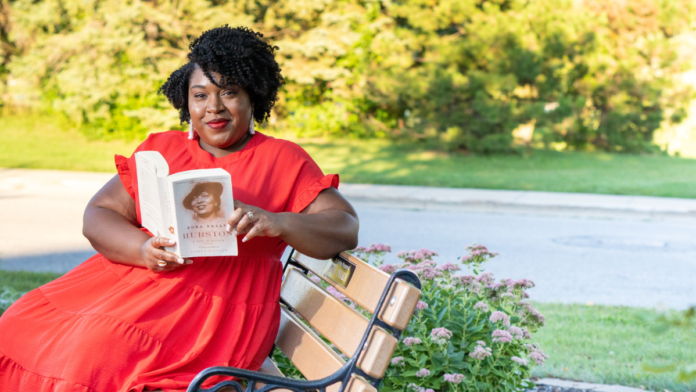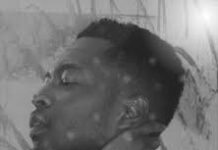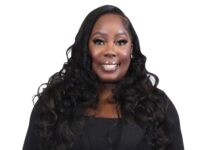( ENSPIRE She Did That ) Chesny Is A Zora Neale Hurston Scholar
ENSPIRE Contributor: Gabrielle Maya
When it comes to sharing stories of history, Black history is rather overlooked. Rae Chesny can do impactful retellings of all things history educationally. She is a Zora Neale Hurston Scholar, an interdisciplinary writer, and a social education expert. Her core focus is researching, writing, and presenting all things Zora Neale Hurston, whom she idolizes.
Chesny is a Johns Hopkins University Literary Consultant who in 2017 created a storyteller program. The Junior Storyteller Program teaches historically underrepresented children how to become published authors. Besides her research journey, she was invited to introduce a Black literary figure for Michigan State University’s Black History Series. Chesny thoroughly researched Langston Hughes, foretold as a wild personal adventure. She is one of the few female representations in the historical literature of the Harlem Renaissance. To continue promoting Zora’s legacy she writes letters and finds parallels with her hero.
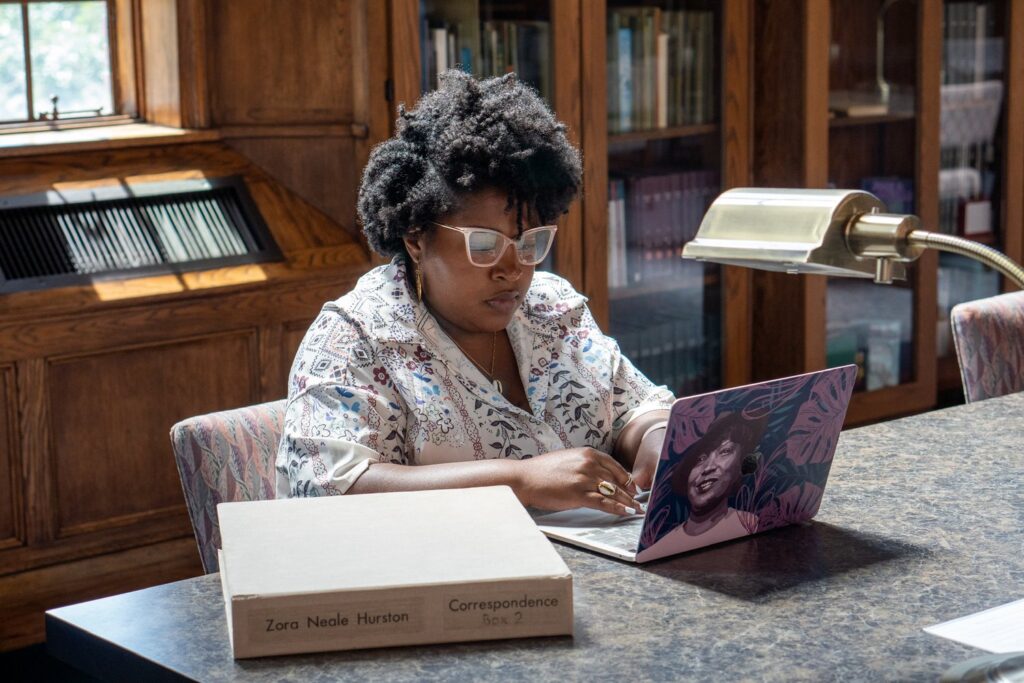
Rae Chesny shares her interest in Zora Neale Hurston and who she was, her own scholarly journey, how she sheds light onto overlooked stories in Black history, her Junior Storyteller Program, and more!
How would you explain who Zora Neale Hurston is to someone who is learning about her for the first time?
For my mature audiences, I would explain that although Zora Neale Hurston is most famously known for her book, Their Eyes Were Watching God, she was a multi-disciplinary genius who worked to preserve Black and African Diasporic heritage in numerous ways. Zora did so as a novelist, playwright, essayist, and trained anthropologist. As a literary luminary, Zora was a mainstay of the Harlem Renaissance. She was the only Black woman to make a career as a writer from the artistic/political movement, making her the most prolific Black woman writer of her time. Her legacy transcends time and space because it is rooted in the exploration of the authentic self for Black and indigenous peoples around the world.
For my younger audiences, I would say that Zora Neale Hurston was a Black woman writer born in the American South in 1891. Zora was professionally trained to travel the American South and the world collecting stories about Black and other people originally from Africa who lived around the world. She used her findings in stories, plays, and books that are still read and celebrated today. Zora wrote the most of any Black woman writer in her time. Her work has inspired many of our literary greats such as Alice Walker, and Toni Morrison. Maya Angelou, and Sonia Sanchez. Unlike her peers, Zora thought that her people were beautiful and artistic in their natural form. So she showed them using the language they spoke in work camps and around their communities.
When did your scholarly path begin and when did you take an interest in Zora?
To be honest, I think my scholarly path began before I even knew that it was happening. In 2015, I was a children’s author running literacy-based summer camps and after-school programs that I had started. The premise of the programs was that if children had diverse children’s books that represented them, their minds would be open to all forms of learning. In 2016, Michigan State University caught wind of what I was doing, and their Residential College in the Arts and Humanities decided to partner with me for after-school programming. MSU students would facilitate programming as a part of their service-learning requirement.
The following year, the presiding professor, Dr. Kevin L. Brooks, approached me to do a Black History Month presentation on the historical figure who most inspired my career as a writer. At that point, I was harboring the secret that I had been a reluctant reader since childhood, so I had no one in mind. But any thought I had of declining the opportunity all but evaporated when he offered me an honorarium.
That year, I decided to do my presentation on Langston Hughes. I figured he was the perfect choice since the Harlem Renaissance was the historical mecca for all Black writers, including myself. I could also recall the famous line from his poem Mother to Son, “Life for me ain’t been no crystal stair…” As a new mother to a beautiful baby boy, I was feeling those words and their gravity in quite a new way. I was enamored with how Langston used simple everyday language in his writing, as well. But as I was researching him, I felt no personal connection. Oddly enough, Zora’s name kept popping up.
I was so shocked that she had been Langston’s best friend during the Harlem Renaissance, that she was raised in the first all-Black incorporated municipality in the US, had a career as a world-traveling anthropologist in the 1920s and 1930s, and wrote prolifically across genres. I remember uttering “Why is nobody talking about Zora?” That’s when I decided to.
That year, I presented on Langston Hughes AND Zora Neale Hurston. Throughout the presentation, I felt guilty in having done so. Zora had been an afterthought. I had made her that, just as others had done throughout history. Every time I said, “And Zora” I felt prickles up my neck and sweat forming under my arms. I said to Zora, in my head, that if I ever had a chance to do another presentation, she would be the star of my show. She has been since. Looking back on that experience, or the seemingly serendipitous Florida trip that landed me in her hometown of Eatonville, FL that summer, I know that it was all aligned. But I wouldn’t see it that way for a few years.
Why did you decide to write letters, if so could you provide a glimpse into what they were about?
The decision to write Zora letters was akin to how writers come up with stories. The idea seems to pop into our head one day and we are brave (or foolish) enough to chase after it until it becomes something that makes sense to other people. It was like that for me. I think it started because I read that Zora communicated primarily with letters throughout her life. She was never financially solvent enough to have phone service in her home, she also moved around a lot, and couldn’t afford telegrams often. That little nugget popped into my mind and it grew as I read Carla Kaplan’s book, Zora Neale Hurston: A Life in Letters. In the book, you don’t see how the receivers of the letters respond to Zora. You only see what she said, yet the letters give you so much. A conversation. I wanted to be in conversation with Zora while being simultaneously terrified to do so. She was a genius. What do you say to a genius?
For me, I was seeking Zora’s permission. I had no business, in my mind, presenting on her. I was no Alice Walker marking Zora’s unmarked grave. Or Valerie Boyd penning a magnificent biography on Zora that married intellectual scholarship with deep love. Or Carla Kaplan editing and annotating 600 letters written by Zora. I was a dejected, longing writer who had lived life as a reluctant reader. I hadn’t even read Their Eyes Were Watching God. That first letter came after my Langston and Zora presentation. It was an apology to her. A recognition that I had been wrong and that I knew it. An illogical hope that I could connect with a woman who died 28 years before I was even born. A petition, if you will. An admission that I had no professorial or scholarly credentials to teach about her legacy, but still I wanted to if she thought I was fit.
Over time, the letters evolved as my journey and our relationship have. They go from polite and permission-seeking, to a gratitude in knowing that Zora chose me to do this work. But they become raw and unfiltered and real as I begin feeling close to her. Truly, the letters are deeply personal. Sometimes they serve as placeholders for me of how I got to this extraordinary place. They serve as witnesses to how my life became what it is and how deeply that is tied to my ever-growing love of Zora. Each letter is framed by my research.
I have chosen to publish the letters with annotations in my forthcoming book Dear Zora. I hope that my journey can inspire others to connect with Zora and to believe in the magic of what is possible for them.
In what ways does Zora mirror yourself?
I don’t know that I am quite brave enough to say that I mirror Zora. I do think we have things in common and I love finding and exploring those things through my research. One thing we have in common is our insatiable curiosity. We also share deep reverence for our heritage and take seriously our chosen role as champions for children. I think that is because we both seem to have had our first showings of independence and imagination as children that have guided us in our different disciplines while framing how we approach our work.
I can also see similarities in how we fight for what convicts us despite the potential and actual repercussions. For our choice to walk the unbeaten path, we have both experienced great triumph and great loss. Even being misunderstood by those closest to us, such as family members.
Zora’s own experience guides me through an unexpected life of ‘hitting a straight lick with a crooked stick’ as she would say. That means when the odds are stacked against you, you still manage to achieve the unlikely. That was Zora. She was a Black woman living at the intersection of racism and sexism, who succeeded beyond what we can conceive today. When there was no way, she seemed to make one still. I believe that it was because she found work that compelled her. Her work is work that we are all still benefiting from today. In that way, I strive to be like her.
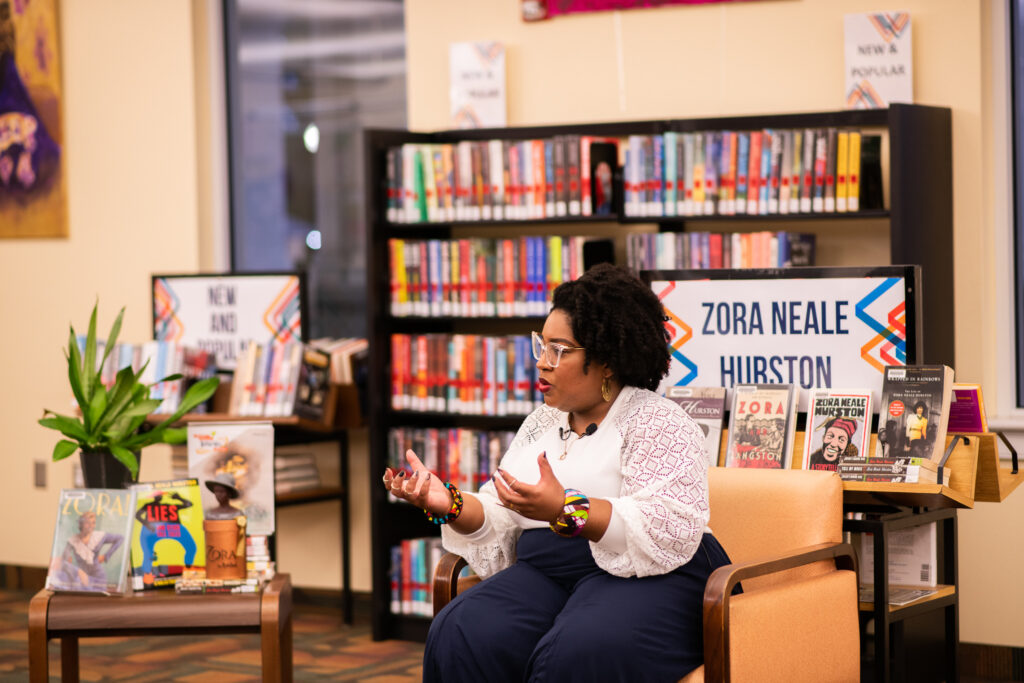
How can we shed more light onto overlooked stories of Black history?
If we want to shed light on overlooked stories in Black history, we first must remove the shame of not having known the stories in the first place. Our history has been so systematically sanitized that we have to re-learn what we thought we knew. I think we have been taught to blame ourselves for not knowing in the first place and that manifests as shame. Shame creates a barrier that holds us hostage from taking the first steps into discovery. Once we have removed the shame from our efforts, we have to help remove it for others. Then, open dialogue and exploration can happen.
I am a prime example.
I wouldn’t consider myself a history buff in the least. Most of what I know and truly understand from history is derived from my relationship with Zora. It comes to life for me through her eyes and experience. From my own experience, I recommend searching for a personal connection with a historical figure, a period, an event, etc. The more connected you feel to the information, the more engaging it will be for you and others. Also, I would say do it in a way that is true to you. Don’t be afraid to get creative.
Why did you create the Junior Storyteller Program, what is your mission?
Junior Storyteller first became an idea after I had done one of my very first school readings as a children’s book author. I was at a local school reading for the day and it had gone well until the end. A 4th grader walked up to me and said, “You didn’t write that book because all authors are old white men with glasses.” I was very taken aback at first, but also impressed by the complexity of what that young boy had said and what he didn’t. When I was a child, I resisted reading because I didn’t see representations of myself in books. This brilliant boy was asserting that not only were the characters important, but so were the authors of the books.
I created Junior Storyteller in 2017 to give children the opportunity to be the ones creating the stories and books they wanted to read. The ultimate goal of Junior Storyteller is to empower our youth to be literacy change agents and peer mentors. The program also diversifies the publishing industry by giving historically represented children first-hand experience with story creation and publishing as a career alongside a published author. I hope that they will continue publishing the stories that they want to see in the world for the rest of their lives.

Are there any upcoming events you are excited about this year that you’d like to share?
This year will end pretty quiet for events. I am working on finishing Dear Zora so that it can be published in 2024. In the meantime, I am opening a virtual Dear Zora Letter Writing Collective for those wishing to know Zora and explore letter writing as a practice to engage with ancestors. Those who wish to join can head to www.dearzora.com to apply. My 2024 calendar is filling up fast, all who wish can follow me @raechesny on Instagram and check in at www.raechesny.com for updates. I am also excited to share that I am working with the familial descendants of Zora Neale Hurston via the Zora Neale Hurston Trust to bring an expansive celebration to the public in early 2025. There will be more to come on that soon. Follow @zoranealehurstontrust on Instagram for updates on that forthcoming event.
Rae Chesny continues to spread education on Zora and the unheard stories of Black history. You can read Chesny’s book Dear Zora: Work In Progress Edition on Amazon. To find out more about Rae Chesny’s events, story, and research on all things Zora Neale Hurston, go visit her site.
Related Articles: Empowering Children’s Future with Super Money Kids, KidVestors Invest in the Future of Public School Finance Education

